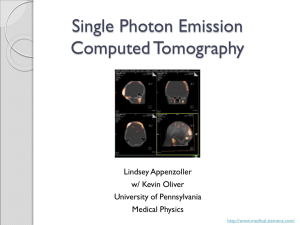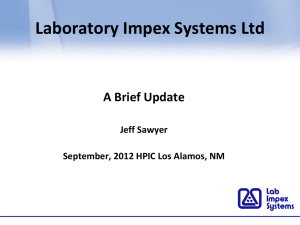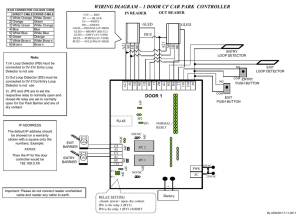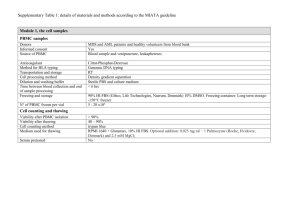Lecture 24
advertisement
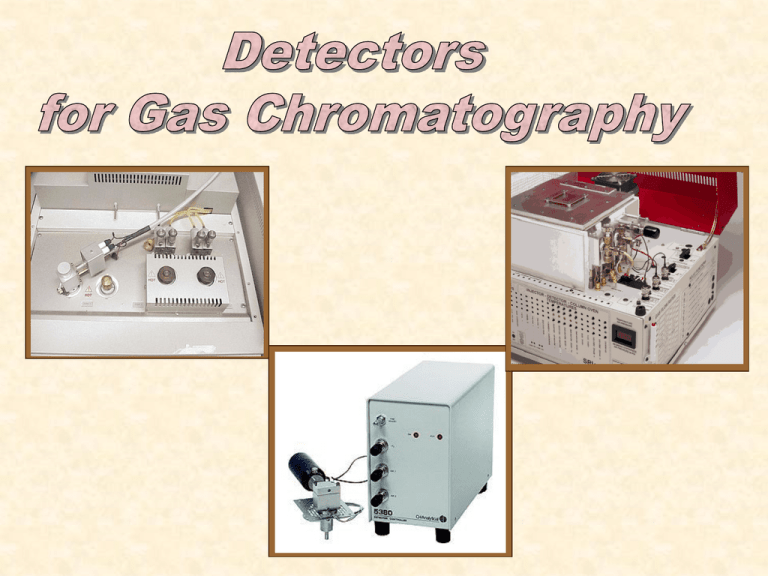
Flame Ionization Detector Most common detector Carbon atoms (C-C bonds) are burned in a hydrogen flame. A small portion of carbon atoms are ionized (about 1 in 10,000), The ions carry a charge from the flame to the walls of the detector which surrounds the flame.The charge is electronically amplified and sent to a recording device. Flame Ionization Detector very robust and reliable. Nitrogen Phosphorus Detector The NPD uses a bead of a compound such as rubidium silicate above a jet of H2. The bead is heated by an electric current forming a plasma. Nitrogen and phosphorous react in the plasma forming specific ions that carry a small current to the charged collector. The NPD is electronically similar to the FID, but since there is no flame, hydrocarbon ionization does not occur. The response to N is 103 – 105 greater than response to C The response to P is 104 – 10 5.5 higher than response to C. The linear dynamic range is 104 It is only fairly reliable since the bead burns up over time causing drift in the signal. Flame Photometric Detector The (FPD) is an element specific detector Commercial instruments are limited to the detection of P and S The analytes are burned in a H2 flame causing electrons to move to an excited unstable state. When the electrons return to the ground state, they emit a specific wavelength of light 526 nm for P and 394 nm for S These wavelengths are monitored by a photomultiplier, amplified, and turned into an electrical signal. This detector is sensitive to 10-9g Linear dynamic range for P of only 103 – 104. For S, the response is non-linear. Flame Photometric Detector Electron Capture Detector The ECD uses a radioactive source such as Ni63 which produces Beta particles which react with the carrier gas producing free electrons. These electrons flow to the anode producing an electrical signal . When electrophillic molecules are present, they capture the free electrons, lowering the signal. The amount of lowering is proportional to the amount of analyte present. It is sensitive down to 10-15 but the dynamic range is only about 104. It’s an excellent detector for molecules containing an electronegative group such as Cl or F etc. (or derivitized molecules). Electron Capture Detector Atomic Emission Detector One of the newest gas chromatography detectors Quite expensive compared to other GC detectors The strength of the AED lies in the detector's ability to simultaneously determine elements. It uses microwave energy to excite helium molecules (carrier gas) which emit radiation which breaks down molecules to atoms such as S, N, P, Hg, As, etc. These excited molecules emit distinctive wavelengths which can be separated by a grating and sent to the detector (typically a photodiode array) which produces the electrical signal. Atomic Emission Detector Photoionization Detector The photoionization detector (PID) uses a UV lamp (xenon, krypton or argon) to ionize compounds. The ionization produces a current between the two electrodes in the detector. The detector is non-destructive and can be more sensitive than an FID for certain compoundssubstituted aromatics and cyclic compounds Photoionization Detector Thermal Conductivity Detector Consists of an electrically-heated wire or thermistor. The temperature of the sensing element depends on the thermal conductivity of the gas flowing around it. Changes in thermal conductivity, such as when organic molecules displace some of the carrier gas, cause a temperature rise in the element which is sensed as a change in resistance. TCD’s are often used to measure lightweight gasses or water (compounds for which the FID does not respond). The TCD is not as sensitive as other detectors but it is a universal detector and is non-destructive. Modern detectors called micro-TCD’s have very small cell volumes, and new electronics that produce much higher sensitivities and wider linear ranges. Due to its increased sensitivity, and the fact that it is a universal non-destructive detector, it is again becoming more popular for certain applications. Thermal Conductivity Detector Thermal Conductivity Detector Representative Thermal Conductivity Values, 100 oC GC Detectors Sensitivities and Ranges


